Past Year Questions: Pavement Design | Transportation Engineering - Civil Engineering (CE) PDF Download
Q1: In the context of pavement material characterization, the CORRECT statement(s) is/are [2024, Set-2]
(a) The load penetration curve of CBR test may need origin correction due to the non-vertical penetrating plunger of the loading machine.
(b) The toughness and hardness of road aggregates are determined by Los Angeles abrasion test and aggregate impact test, respectively.
(c) Grading of normal (unmodified) bitumen binders is done based on viscosity test results.
(d) In compacted bituminous mix. voids in the mineral aggregate (VMA) is equal to the sum of total volume of air voids (Vv) and total volume of bitumen (Vb).
Ans: (a), (c), (d)
Sol: In a bituminous mix
VMA = Voids in mineral aggregate
VMA = Vb% + Vv%
where, Vb% = Percentage volume of bitumen
Vv% = Percentage air voids
Toughness is determined by aggregate impact test and hardness is determined by los angeles abrasion test.
An initial concavity in CBR curve indicate errors which may occur due to following reasons and also require correction
Top layer of soil too soft
Top surface of soil specimen is not even
The penetration plunger of the loading machine is not vertical and the bottom of plunger is not horizontal.
Q2: The following data is obtained from an axle load survey at a site: [2024, Set-1]
Average rear axle load -12000 kg.
Number of commercial vehicles = 800 per day
The pavement at this site would be reconstructed over a period of 5 years from the date of survey. The design life of the reconstructed
pavement is 15 years. Use the standard axle load as 8160 kg and the annual average vehicle growth rate as 4.0% Assume that Equivalent
Wheel Load Factor (EWLF) and Vehicle Drainage Factor (VDF) are equal
The cumulative standard axle (in msa) for the pavement design is (rounded off to 2 decimal places)
Ans: 33.22
Sol: Number of commercial vehicles = 800 vehicles per day
For vehicle growth rate of 4%,
Number of commercial vehicles after construction period,
A = 800 × [1 + 0.04]5= 973.32 veh
Vehicle damage factor,
∴ Cumulative standard axle (in msa)

Q1: For an axle load of 15 tonne on a road, the Vehicle Damage Factor (round off to two decimal places), in terms of the standard axle load of 8 tonne, is _________. [2020, Set-2]
Ans: 12.3 to 12.4
Sol: Axle load = 15 T
Standard axle load = 8 T
VDF= [15/8]4 = 12.35
Q2: A dowel bar is placed at a contraction joint. When contraction occurs, the concrete slab cracks at predetermined location(s). Identify the arrangement, which shows the correct placement of dowel bar and the place of occurrence of the contraction crack(s). [2020, Set-1]
(a) 
(b) 
(c) 
(d) 
Ans: (b)
Q3: A road in a hilly terrain is to be laid at a gradient of 4.5%. A horizontal curve of radius 100 m is laid at a location on this road. Gradient needs to be eased due to combination of curved horizontal and vertical profiles of the road. As per IRC, the compensated gradient (in %, round off to one decimal place), is _____ [2020, Set-1]
Ans: 4
Sol: Gradient = 4.5%,R = 100 m
Grade compensation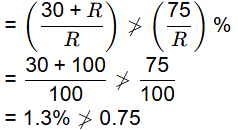
G.C > = 0.7
Compansated Gradient = Gradient G.C = 4.5% - 0.75 = 3.75 4%
4%
Hence C.G = 4%
Q1: A flexible pavement has the following class of loads during a particular hour of the day.
(i) 80 buses with 2-axles (each axle load of 40 kN);
(ii) 160 trucks with 2-axles (front and rear axle loads of 40 kN and 80 kN, respectively)
The equivalent standard axle load repetitions for this vehicle combination as per IRC:37-2012 would be [2019, Set-2]
(a) 250
(b) 320
(c) 180
(d) 240
Ans: (c)
Sol: (i) 80 buses with 2 axle with 40 kN each.
N1 = 80 x 2 = 160
L1 = 40 kN
N1 = 160, L1 = 40kN
N2 = 160, L2= 80kN

N1 = 320, L1 = 40kN
N2 = 160, L2 = 80kN
As per 4th power law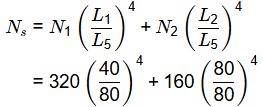
= 20 + 160 = 180
Q2: A parabolic vertical curve is being designed to join a road of grade +5% with a road of grade -3%. The length of the vertical curve is 400 m measured along the horizontal. The vertical point of curvature (VPC) is located on the road of grade +5%. The difference in height between VPC and vertical point of intersection (VPI) (in m, round off to the nearest integer) is _____ [2019, Set-1]
Ans: 10
Sol:
Given, N1 = +5% N2 = -3%
Length of summit curve is, l = 400 m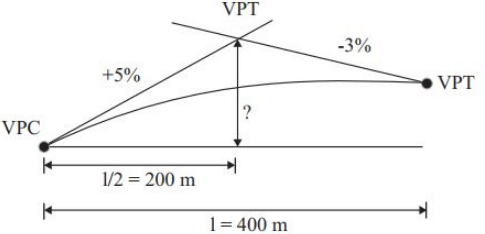

Q3: Average free flow speed and the jam density observed on a roadstretch are 60 km/h and 120 vehicles/km, respectively. For a linear speed-density relationship, the maximum flow on the road stretch (in vehicles/h) is _______ [2019, Set-1]
Ans: 1800
Sol: Maximum Speed / Free ? ow speed, Vm = 60kmph
Jam density, Km = 120 kmph
for linear speed - density (Green shield's model) relationship, 
Q4: Structural failures considered in the mechanistic method of bituminous pavement design are [2019 : 1 Mark, Set-II]
(a) Fatigue and Rutting
(b) Fatigue and Shear
(c) Shear and Slippage
(d) Rutting and Shear
Ans: (a)
Q5: Tie bars of 12 mm diameter are to be provided in a concrete pavement slab. The working tensile stress of the tie bars is 230 MPa, the average bond strength between a tie bar and concrete is 2 MPa. and the joint gap between the slabs is 10 mm. Ignoring the loss of bond and the tolerance factor, the design length of the tie bars (in mm, round off to the nearest integer) is________. [2019, Set-1]
Sol:
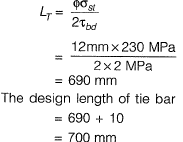
Q6: An isolated concrete pavement slab of length L Is resting on a frictionless base. The temperature of the top and bottom fibre of the slab are Tt and Tb, respectively. Given: the coefficient of thermal expansion = α and the elastic modulus = E Assuming Tt > Tb and the unit weight of concrete as zero, the maximum thermal stress is calculated as [2019, Set-1]
(a) 
(b) 
(c) 
(d) Zero
Ans: (d)
Sol:

Q1: Given the following data: design life n = 15 years, lane distribution factor D = 0.75, annual rate of growth of commercial vehicles r = 6%, vehicle damage factor P = 4 and initial traffic in the year of completion of construction = 3000 Commercial Vehicles Per Day (CVPD). As per IRC : 37-2012, the design traffic in terms of cumulative number of standard axles (in million standard axles, up to two decimal places) is ________ [2018, Set-1]
Ans: 75 to 78
Sol:

Q1: The radii of relative stiffness of the rigid pavements P and Q are denoted by lp and lQ, respectively. The geometric and material properties of the concrete slab and underlying soil are given below:
The ratio (up to one decimal place) of  is _______. [2017 : 2 Marks, Set-II]
is _______. [2017 : 2 Marks, Set-II]
Solution:
Relative stiffness,
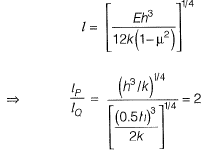
Q2: In the context of the IRC 58-2011 guidelines for rigid pavement design, consider the following pair of statements.
I. Radius of relative stiffness is directly related to modulus of elasticity of concrete and inversely related to Poisson’s ratio.
II. Radius of relative stiffness is directly related to thickness of slab and modulus of subgrade reaction.
Which one of the following combinations is correct? [2016 : 1 Mark, Set-II]
(a) I. True; II. True
(b) I. False; II. False
(c) I. True; II. False
(d) I. False; II. True
Answer: (b)
Solution: Radius of relative stiffness,

As μ increases then 1 - μ2 decreases
∴ Relative stiffness also increases.
∴ Statement 1 is false.
As modulus of subgrade reaction (k) increases, (I) decreases
∴ Statement 2 is false.
Q3: A traffic survey conducted on a road yields an average daily traffic count of 5000 vehicles. The axle load distribution on the same road is given in the following table:
The design period of the road is 15 years, the yearly traffic growth rate is 7.5% and the load safety factor (LSF) is 1.3. If the vehicle damage factor (VDF) is calculated from the above data the design traffic (in million standard axle load, MSA) i s _________ . [2014 : 2 Marks, Set-I]
Solution: Vehicle damage factor
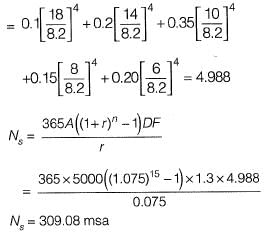
Q4: The following statements are related to temperature stresses developed in concrete pavement slabs with free edges (without any restraint):
P. The temperature stresses will be zero during both day and night times if the pavement slab is considered weightless.
Q. The temperature stresses will be compressive at the bottom of the slab during night time if the self-weight of the pavement slab is considered.
R. The temperature stresses will be compressive at the bottom of the slab during day time if the self-weight of the pavement slab is considered
The TRUE statement(s) is(are) [2014 : 1 Mark, Set-I]
(a) P only
(b) Q only
(c) P and Q
(d) P and P only
Answer: (c)
Solution: The temperature stress will be tensile at the bottom of the slab during the day time if the self weight of the pavement slab is considered.
Q5: Select the strength parameter of concrete used in design of plain jointed cement pavement from the following choices: [2013 : 1 Mark]
(a) Tensile strength
(b) Compressive strength
(c) Flexural strength
(d) Shear strength
Answer: (c)
Solution: Rigid pavement transfers the load by bending action, so flexural strength of concrete used should be high.
Q6: A pavement designer has arrived at a design traffic of 100 million standard axles for a newly developing national highway as per IRC:37 guidelines using the following data : life = 15 years, commercial vehicle count before pavement construction = 4500 vehicles/day, annual traffic growth rate = 8%. The vehicle damage factor used in the calculation was [2012 : 2 Marks]
(a) 1.53
(b) 2.24
(c) 3.66
(d) 4.14
Answer: (b)
Solution:
Number of commercial vehicles per day,
A = 4500
Annual traffic growth rate,
r = 8%
Design life,
n = 15 years
The cumulative standard axles,
N8 = 100 x 106
Vehicle damage factor used
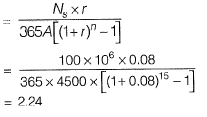
Q7: Consider the following statements in the context of cement concrete pavements:
1. Warping stresses in cement concrete pavements are caused by the seasonal variation in temperature.
2. Tie bars are generally provided across transverse joints of cement concrete pavements.
The correct option evaluating the above statements is [2010 : 2 Marks]
(a) 1 true and 2 false
(b) 1 false and 2 true
(c) 1 true and 2 true
(d) 1 false and 2 false
Answer: (d)
Solution: Warping stresses in cement concrete pavements are caused by the daily variation in temperature. Tie bars are generally provided across longitudinal joints of cement concrete pavements
|
26 videos|92 docs|58 tests
|
FAQs on Past Year Questions: Pavement Design - Transportation Engineering - Civil Engineering (CE)
| 1. What are the main factors to consider in pavement design? |  |
| 2. How do you determine the thickness of pavement layers? |  |
| 3. What is the difference between flexible and rigid pavements? |  |
| 4. What role does drainage play in pavement design? |  |
| 5. How can pavement design impact road safety? |  |






















